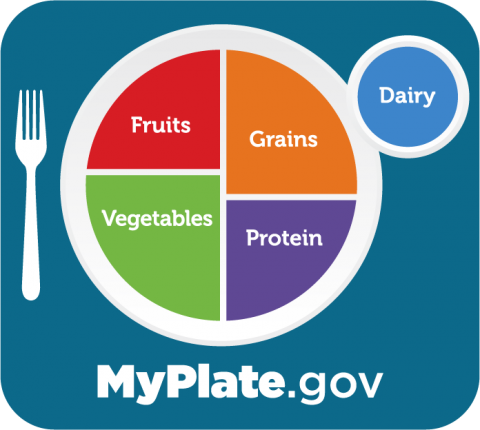3 Great Reasons You Should Eat Carbs
What are Carbs?
Carbs, or carbohydrates, are often made out to be the enemy of a healthy diet with media headlines that encourage cutting down or cutting them out completely. Carbs are often blamed for hindering weight loss and sabotaging your self-control, but they are misunderstood by many. Carbs are an essential nutrient and the body's main source of energy. Although many people refer to carbs as a whole food group made of breads, pasta, crackers and sweets, they exist as a nutrient found in many food groups. Take the MyPlate model, for example: carbohydrates can be found in fruits, vegetables, grains, protein sources (from plants) and dairy - all five sections of MyPlate, and all part of a healthy lifestyle.

There are two main types of carbs - simple and complex. All carbs eventually break down into sugar (called glucose) in the body, which is used in metabolism to make energy. Simple carbs in food exist in a form already close to sugar, which are quickly broken down and absorbed (think white bread, soft drinks, candy, etc.) Complex carbs, as their name suggests, have more complicated structures that take longer to break down into sugar (think vegetables, whole grain bread, brown rice, etc.). Complex carbs have some benefits over simple carbs, but all foods that contain carbohydrates have their place in a healthy lifestyle.
Carbs are your body's preferred source of energy
Carbohydrates are a type of nutrient found in a variety of foods that give your body energy, help you get the nourishment you need and keep things running smoothly. Foods that have the most carbs, fiber and nutrients are fruits, vegetables and whole grains.
There's a reason the USDA recommends that 45-65% of the food you eat should contain carbohydrates1 - sugar (broken down from the carbs you eat) is the easiest source of energy for every cell in your body to use.2 This energy is needed to breathe, think, run, jump and grow. So, whether you're chasing a toddler, running a marathon or reading a book, carbs will give you the energy you need to succeed.
Many carb-rich foods are sources of micronutrients
Forget a daily multivitamin, many carbohydrate foods are packed with micronutrients. Remember fruits and vegetables? Huge source of essential vitamins and minerals including vitamins A, C, and E, potassium, folate, B vitamins and several antioxidants.3 Whole grains and enriched grain products are also full of micronutrients. We have virtually eliminated several nutrition-related diseases in the United States thanks to enrichment of grain products with essential nutrients such as folate, riboflavin, niacin and thiamin.4 However, foods in the grains group tend to vary in nutritional content and quality. Whole grains like brown rice, quinoa and whole grain bread already contain the micronutrients that processed grains are enriched with, but processed grain products often contain more added sugar and less fiber. This is why the USDA recommends making half of your grains whole grains.1
Complex carbs are a great source of fiber
Fiber helps our bodies in more ways than you may think. Fiber is a component of plant-based foods that can't be digested but has a lot of health benefits. Ever wondered why some boxes of cereal are advertised as "heart healthy"? That's because fiber helps lower cholesterol in the blood and low cholesterol corresponds with low risk of heart disease. Fiber also slows down digestion in a way that helps you feel full longer but keeps things moving in a way that reduces risk of colon cancer. It is a natural pre- and probiotic that feeds the good bacteria in your gut which promotes overall a healthy, balanced body.
Despite all of fiber's benefits, up to 93% of the US population do not eat enough of it.5 This is largely due to the widespread processing of grains, which strips them of fiber and other nutrients - only the nutrients are put back in through enrichment, the fiber is not. This is why the Dietary Guidelines for Americans recommends making sure at least half of the grain products you eat are made with whole grains.6 It is important to check the nutrition facts label and ingredients list when buying grain products because some products advertised as "whole wheat" are not truly "whole grain" and therefore do not contain all the benefits of whole grain foods. On the nutrition facts label, a daily value fiber content about 20% is considered a high-fiber food and below 5% is considered a low-fiber food. Next time you're in the cereal aisle try adding a high-fiber cereal to your cart!
References
- Dietary Guidelines for Americans 2020-2025. Accessed February 24, 2022. https://www.dietaryguidelines.gov/sites/default/files/2021-03/Dietary_Guidelines_for_Americans-2020-2025.pdf
- Carbohydrates. Accessed February 24, 2022. https://medlineplus.gov/carbohydrates.html
- Vegetables – MyPlate. Accessed February 24, 2022. https://www.myplate.gov/eat-healthy/vegetables
- Enrichment & Fortification. Grain Foods Foundation. Accessed February 27, 2022. https://grainfoodsfoundation.org/enriched-grains/enrichment-fortification/
- Most Americans are not getting enough fiber in our diets. American Society for Nutrition. Published June 9, 2021. Accessed February 27, 2022. https://nutrition.org/most-americans-are-not-getting-enough-fiber-in-our-diets/
- FDA Dietary Fiber Fact Sheet. https://www.accessdata.fda.gov/scripts/interactivenutritionfactslabel/assets/InteractiveNFL_DietaryFiber_October2021.pdf
Check Out Our New Health & Well-Being Page
Our specialists help create healthy people and healthy places in New Hampshire.
Featured LINK
Mental Health Resources for New Hampshire - a printable county-specific guide to help New Hampshire residents find local, state, and national mental health resources.

